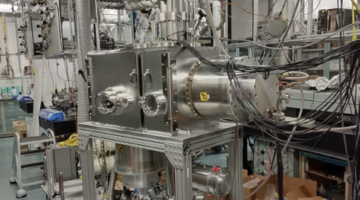-
-
-
- A new leap in understanding nickel oxide superconductors
- Better energy output by understanding power loss in organic solar cells
- Designer materials to keep plastic out of landfills
- Machine learning paves way for smarter particle accelerators
- LEEP summit features Cyclotron Road, DOE lab-embedded entrepreneurship programs
- An old tube holds key to 30 year protein structure mystery
- How proteins form tooth enamel
-
-
Memories of David Kilcoyne from the ALS Community
David Kilcoyne was a longtime member of the ALS community, working on a number of different beamlines starting in 1999. He passed away in June 2022 and will be missed dearly. Read: Memorial Article for David Kilcoyne Read: Memories of David Kilcoyne By His Sister Ruth We have collected memories from the ALS community toRead More Read more »
Memories of David Kilcoyne by His Sister Ruth
by Ruth Kilcoyne Fulcher David Kilcoyne was a longtime member of the ALS community, working on a number of different beamlines starting in 1999. He passed away in June 2022 and will be missed dearly. My earliest memories of David were his tireless capacity to be busy all of the time. He was a cheerfulRead More Read more »
ALS in the News (June 2022)
ALS in the News (May 2022)
-
-
-
- Not just pollen in the spring: Wild grass releases a variety of particles into the air
- DOE Office of Science budget: FY22 outcomes and FY23 request
- Senate confirms Berhe as federal Office of Science director
- Four Berkeley Lab scientists elected to the American Academy of Arts and Sciences
- Physics Ph.D. student awarded fellowship at Berkeley Lab
- 75 Years of Science with Synchrotron Light (lightsources.org virtual symposium recording)
- Unlocked enzyme structure shows how strigolactone hormone controls plant growth
-
-
ALS in the News (April 2022)
ALS in the News (March 2022)
-
-
-
- Scientists uncover surprising new clues to exotic superconductors’ superpowers
- Growing extremely tiny, uniformly sized diamonds—without explosives
- Scientists discover how molecule becomes anticancer weapon
- How x-rays can make better batteries
- Safely studying dangerous infections just got a lot easier
- Metal-organic frameworks can capture toxic air pollutants
- Common scaling of strange-metal scattering in unconventional superconductors
-
-
ALS in the News (February 2022)
-
-
-
- Scientists discover ‘secret sauce’ behind exotic properties of new quantum material
- Plant smoke detectors evolve as hormone sensors
- Autofocus for x-ray crystallography: How AutoML targets samples at the ALS
- With a little help, new optical material assembles itself
- Coral skeleton formation rate determines resilience to acidifying oceans
-
-
ALS in the News (January 2022)
-
-
-
- COVID: How one person’s cells led to our only antibody treatment for omicron
- Physicists discover ‘secret sauce’ behind exotic properties of new quantum material
- Secondary structures in DNA are associated with cancer
- Berkeley Lab’s top 10 science stories of 2021
- New technique visualizes every pigment cell of zebrafish in 3D
- New device advances commercial viability of solar fuels
- Visualising cell structures in three dimensions in mere minutes
-
-
ALS in the News (December 2021)
-
-
-
- BCSB determines interactions of potential inhibitor with SARS-CoV-2 protease
- Howard Padmore receives Berkeley Lab lifetime achievement award
- Collin Foster to spend a study year at Berkeley Lab
- Professor Daniel Knopf tries to predict how ice forms in clouds
- Converting methane to methanol – with and without water
- Berkeley Lab awarded more than $13 million for electric vehicle battery research
- Revolutionizing data access through Tiled
- Government scientists recover hypothesized crystal from deep within earth
-
-
- « Previous Page
- 1
- …
- 3
- 4
- 5
- 6
- 7
- …
- 23
- Next Page »

